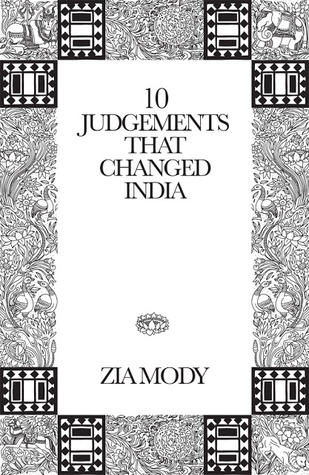10 Judgements That Changed India by Zia Mody - Review by Abhishek Desikan
India’s story, post Independence, can be illustrated through different lenses - historical, political, geographical, to name a few. It is not often that one views India from a judicial perspective, and 10 Judgements That changed India does precisely that. By analyzing landmark judgments by the highest court of the land in the decades post-independence, the author vividly paints how our country’s law and constitution have impacted its turn of events and evolved to their current state.
Of the 10 judgments discussed, there are famous ones like Kesavananda Bharati vs. the State of Kerala, where the Supreme Court came up with the basic structure doctrine to analyze constitutional amendments, and Shah Bano vs. Mohammed Ahmed Khan, where the sanctity of personal religious law was brought to the forefront. But there are also lesser-known cases discussed in great detail, like Nilabati Behera vs. State of Orissa, where the right to compensation for violating Article 21 was crystallized, and Aruna Shanbaug vs. Union Of India where the decision on euthanasia and the circumstances where it can be allowed were decided.
In reading the lead-up and aftermath of these judgments, the author lucidly explains the laws' historical background and the various challenges before the Supreme Court as it made its decisions. We learn about the different fundamental rights and their applicability, the nuances in interpretations of articles in the constitution, and the executive, legislature, and judiciary’s role as the framers of the constitution envisioned it. We also see how the Supreme court went beyond its ambit many times to establish the rule of law, reversed its own decisions many times, and even criticized them. This is highlighted in Supreme Court Advocates-on-Record Association vs. Union of India, where it granted itself too much power to determine judges' appointments.
It was also interesting to note how the executive and legislature reacted to the judgments which weren’t in their favor. The most famous among these was the aftermath of Kesavananda Bharati which led to the emergency and drastic amendments of the constitution and appointment and transfer of various judges going against protocol. The checks and balances between the 3 pillars of our democracy have routinely been strained. This makes one realize how it is a privilege to live in a democratic society that allows these pillars to operate fluidly.
The Supreme Court is held in high esteem in India as the last bastion of hope for the common man. It is truly a testament to its dedication to uphold the rule of law and establish justice as it sees fit. This book is a must-read for law enthusiasts and anyone curious to understand the judicial history of India.

Originally published here.